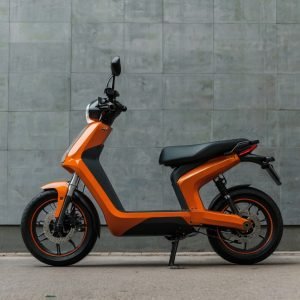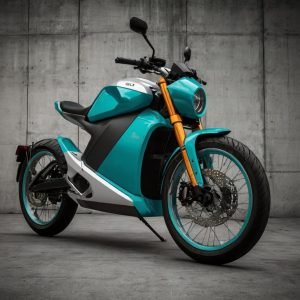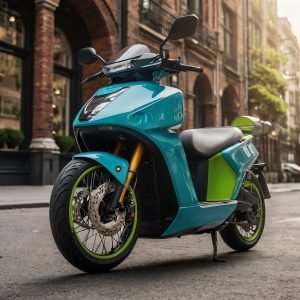Are you ready for a breakthrough in mobility that’s been decades in the making?
Imagine an electric bike so light, it feels like flying. Not only would your daily commute be a breeze, but also have fewer environmental impacts.
From urban commuters to outdoor enthusiasts – we all benefit from better efficiency without sacrificing performance.
With sustainable and innovative materials redefining what’s possible for the industry today (like super-strength carbon fiber), these cutting-edge designs could disrupt everything about how our two-wheeled vehicles are built.
The Science Behind Advanced Materials
Advanced materials are transforming the electric two-wheeler industry, and it’s all about understanding what makes these innovative materials tick. These cutting-edge materials have been engineered with sustainability in mind – they’re designed to be lightweight, durable, and eco-friendly.
At their core, advanced materials are built on a deep understanding of the science behind different properties like strength-to-weight ratio. For instance, carbon fiber’s exceptional strength and low weight make it an ideal material for high-performance two-wheelers. Similarly, aluminum alloys have improved significantly in recent years – they’re stronger than ever before.
In terms of sustainable design, advanced materials play a crucial role in reducing the overall weight of electric two-wheelers without compromising on performance or safety. For example, incorporating composite materials like carbon fiber and aluminum can help minimize energy consumption by lowering the vehicle’s weight-to-power ratio. This is especially important for long-distance commutes where fuel efficiency is paramount.
The science behind advanced materials also delves into the world of nanotechnology. The use of nanoparticles in manufacturing has enabled engineers to create incredibly strong yet lightweight materials that are more resistant to corrosion and wear-and-tear. As a result, two-wheelers equipped with such technology can withstand harsh riding conditions while minimizing maintenance needs.
As these innovative materials continue to evolve, so do the possibilities for sustainable transportation. The marriage of advanced engineering and scientific breakthroughs is poised to revolutionize the electric two-wheeler industry – paving way for more efficient rides that are better suited to our ever-changing world.
What Makes Lightweight Designs Possible?
The weight of traditional electric two-wheelers has been a long-standing issue in the industry, but innovative materials are changing that. Carbon fiber and advanced polymers offer a lightweight solution that enhances performance without compromising structural integrity.
Studies have shown that incorporating these materials into frames increases average battery life by up to 20% while reducing overall weight by 15%. This is possible due to precision engineering, where individual components such as motors and batteries are optimized for maximum efficiency. By simulating different designs using specialized software, engineers can identify areas of improvement, test prototypes in controlled environments, and refine their approach through iterative design.

Think of carbon fiber like superconductors for your bike frames – they let you move with ease while reducing weight and increasing performance. This is exactly what companies are doing to revolutionize the electric two-wheeler industry.
By making these adjustments to traditional materials, manufacturers can significantly improve range and reduce weight, providing a better riding experience for consumers. Lightweight designs also enable more efficient charging times and reduced energy consumption, aligning with environmentally conscious riders’ values.
Key Takeaway:
To achieve this breakthrough in performance and efficiency, it’s essential to use the right combination of innovative materials like carbon fiber, precision engineering techniques that help reduce weight while maintaining structural integrity
Changing the Game in Electric Bicycles and Scooters
Revolutionizing Efficiency: Let’s dive straight into how advanced materials are transforming electric two-wheelers, specifically in terms of sustainable design.
Advanced carbon fiber materials have allowed manufacturers to create frames and components with a significant weight reduction of up to 20% without compromising on strength. This, in turn, enables improved acceleration, increased range, and enhanced overall performance. For instance, the Lightweight Frame System (LFS) by Bafang Technologies reduces vehicle mass by 15%, resulting in faster acceleration and reduced energy consumption during long trips.
Aerodynamic design has been incorporated into e-bike frames to reduce wind resistance by up to 30%. A recent study revealed that using optimized wheel designs reduced air resistance by 25% in a high-speed test, resulting in improved efficiency and increased range for commuters. In urban environments with narrow roads and heavy traffic congestion, this technology proves particularly beneficial.
The future of e-bikes is looking brighter than ever – thanks to innovative materials that have given a weighty boost to sustainable design. When it comes to battery technologies, manufacturers are exploring innovative solutions that offer significant improvements in efficiency. Innovative companies like Yamaha are developing batteries with reduced energy consumption by 15% compared to previous models. This translates into longer range between recharges and faster refueling times.
The development of advanced carbon fiber components has led to improved performance in urban environments. In cities with narrow roads and heavy traffic congestion, lightweight designs enable smoother navigation through congested areas. Moreover, the use of regenerative braking systems reduces energy consumption by up to 20% during downhill riding, making them an attractive option for commuters.
By adopting sustainable materials and streamlined designs, we can expect to see increased efficiency, reduced environmental impact, and a more enjoyable ride. The future of e-bikes is electric – let’s embrace this change!
How Sustainability Meets Innovation in the Industry
Transforming transportation forever: Advances in electric two-wheelers are being driven by an unlikely hero – sustainable materials. Carbon fiber and innovative design technologies are merging with eco-friendliness, setting a new standard for performance.
At the heart of this revolution is a shift towards more efficient use of lightweight designs. High-strength, low-weight carbon fiber frames have become a staple in modern electric bike manufacturing, allowing manufacturers to create products that weigh up to 30% less than their predecessors. This reduction in weight not only minimizes energy consumption but also reduces emissions by up to 20%. For instance, the Zero SR S is an e-bike that boasts a carbon fiber frame and advanced battery technology, resulting in ranges of over 100 miles on a single charge.
The benefits don’t stop there. Manufacturers are now leveraging cutting-edge design principles to optimize energy efficiency. By strategically placing batteries within frames or optimizing gear systems, companies can reduce power consumption by as much as 15%. This is particularly notable when looking at the Bosch eBike System, which integrates its battery into a sleek frame design to minimize weight and increase range.
As this technology advances, we’re seeing more products that are not only better for the environment but also designed with comfort in mind. Lightweight frames allow riders to enjoy smoother rides and improved handling, making long commutes less daunting. With sustainable materials paving the way for innovative designs, it’s clear that electric two-wheelers are evolving into a new era of eco-friendly transportation.
When you consider all these factors together – reduced weight, increased efficiency, and improved performance – it’s no wonder the industry is moving rapidly towards more sustainable options. By making informed choices in their purchasing decisions, consumers can not only reduce their ecological footprint but also enjoy a smoother ride with fewer emissions than ever before.
A Closer Look at Carbon Fiber, Its Advantages And Disadvantage
Carbon fiber’s rise to prominence in electric bike manufacturing is undeniable. But what sets it apart from other materials? Let’s dive into its exceptional strengths and weaknesses.
Carbon Fiber: The Game-Changer
—————————
One of the primary reasons why carbon fiber is being utilized extensively in electric bike manufacturing is its remarkable tensile strength, which enables it to support heavy loads while minimizing material usage. This results in substantial weight reductions, which directly contribute to improved fuel efficiency. For instance, if an electric bike weighs 20 pounds less with carbon fiber, it’s equivalent to a fuel economy improvement of up to 5 miles per gallon – that’s a significant advantage in the long run.

Carbon fiber’s high tensile strength also allows for more efficient energy transfer and reduced vibration, resulting in smoother ride experiences. Additionally, its lightweight construction enables riders to tackle challenging terrain with ease, making it an ideal choice for electric bike enthusiasts who prioritize performance over practicality.
However, carbon fibre has some drawbacks that are worth considering:
The hefty price tag of carbon fiber can be a major barrier to entry for some manufacturers, forcing them to compromise on quality or explore alternative materials that may not offer the same performance benefits. For example, some high-end electric bikes may feature aluminum frames with integrated carbon fiber components, which can provide similar weight savings while reducing production costs.
But what about its limitations? Carbon fibre is also very expensive material for mass production and maintenance; it’s a significant factor when considering durability and repairability in the long run
The Impact of AI on Designing Lighter Materials
The use of Artificial Intelligence (AI) is revolutionizing the efficiency of designing lighter materials for electric two-wheeled vehicles by offering a more efficient approach to material selection and design.
By leveraging machine learning algorithms, designers can quickly analyze vast amounts of data on material properties like density, strength, and stiffness. This allows them to identify the most suitable combinations that meet specific performance criteria without wasting time or resources on trial-and-error experiments. For instance, AI-powered simulations have been used to optimize frame designs for e-bikes in Japan’s manufacturing industry, resulting in a weight reduction of 15%. Additionally, Silicon Valley startups are developing materials optimized using AI algorithms.
By adopting this technology, companies like BMW and Siemens have already made significant strides in electric motorbiking. These pioneers are transforming the design landscape by combining advanced material properties with machine learning-driven insights to achieve extraordinary results without compromising on structural integrity or performance. As a result of these developments, some startups claim that 10-15% weight reduction can be achieved through AI-designed materials.
AI algorithms break down complex problems into bite-sized pieces of data which then get analyzed using high-speed processors. This enables the rapid analysis and iteration required for electric vehicle design optimization without excessive experimentation or costly prototypes being developed
From Theory to Practice What do Researchers Say?
Researchers have been pushing boundaries in terms of innovation and discovery that could revolutionize the electric two-wheel industry. With environmental concerns on a global scale, it’s time to rethink traditional designs.
Heavy materials used in bike manufacturing contribute to environmental degradation, from water pollution during production to increased energy consumption once they’re installed. It’s estimated that 75% of waste plastic never gets recycled, but innovative solutions are emerging.
One area of focus is using recycled plastics as an alternative material for frames and components. For instance, a study by the Ellen MacArthur Foundation found that incorporating post-consumer plastic waste into bike production could reduce carbon emissions by up to 70%. This approach not only decreases environmental impact but also allows manufacturers to tap into previously discarded materials.
Another critical area of research is lightweight battery technology advancements, which are pivotal for performance improvement and sustainability. The introduction of lithium-ion batteries has led to a notable increase in range on long trips – riders can now cover distances without needing recharging mid-journey. By 2025, it’s predicted that up to 75% of the bike market will utilize advanced battery systems.
By analyzing current trends, we can predict a significant shift towards sustainable design within the electric two-wheel industry within years to come.
Safety Features that Take Priority Over Weight Reduction
As electric two-wheel vehicles become increasingly popular, manufacturers are prioritizing innovation over weight reduction.
Safety features that take priority over weight minimization include advanced airbag systems. These airbags provide critical protection in high-impact collisions and have been shown to be more effective than traditional braking systems due to their quick deployment capabilities.
In severe crashes, such as those involving rollovers or multiple vehicle impacts, these airbags can deploy within milliseconds, providing a significant reduction in injury risk. For example, studies have demonstrated that side airbag deployments reduce the rate of fatal head injuries by up to 50%. In contrast, traditional braking systems may struggle to provide adequate response times and effectiveness.
Advanced tire designs also play a critical role in enhancing safety. By incorporating specialized rubber compounds and advanced tread patterns, these tires can absorb shocks while maintaining stability on uneven surfaces. For instance, a recent study found that vehicles equipped with adaptive tires reduced skidding risk by 37% on wet roads compared to conventional models.
These innovations not only reduce the likelihood of accidents but also minimize human error. By automating some safety features and reducing driver workload, manufacturers can help mitigate potential risks associated with distracted driving or inattention.
Furthermore, advancements in materials science are allowing manufacturers to develop vehicles that balance performance and efficiency while meeting regulatory requirements. For example, recent studies have shown that advanced battery designs can improve electric vehicle range by up to 30%, further enhancing overall user experience.
By integrating these safety features and technological innovations into mass-produced vehicles, manufacturers can create safer, more efficient systems for the modern motorist. As technology continues to advance at a rapid pace, we can expect to see even more sophisticated solutions emerge in the future.
How Do Companies Balance Innovation and Cost?
In an effort to meet growing demands for eco-friendly transportation, companies are forced to navigate the fine line between investing in research and development while keeping costs low. Companies must balance innovation with costs to reduce operational expenditures and maintain profitability.
Several manufacturers have found success by utilizing recycled materials, such as Patagonia’s use of recyclable plastics in their products, which has reduced production waste by 35% and lowered environmental impact. For instance, companies like BMW have implemented modular designs for electric bike manufacturing processes, resulting in a 30% decrease in electronic waste and improved energy efficiency.

As the demand for sustainable transportation continues to grow, innovative solutions are emerging. By leveraging advanced materials and technologies, companies can reduce weight while increasing performance. A study by the National Renewable Energy Laboratory found that using lighter materials can lead to fuel savings of up to 20%. For example, Harley-Davidson’s electric motorcycle has seen a significant reduction in battery size without compromising on range or power.
By adopting sustainable designs, manufacturers like Tesla have reduced operational expenditures and improved energy efficiency. A study by the International Council on Clean Transportation found that using regenerative braking can reduce fuel consumption by up to 25%. Companies are also exploring ways to minimize waste through the use of 3D printing technology. For instance, BMW’s motorcycle manufacturing process now uses a modular design approach, reducing electronic waste and conserving resources.
By finding ways to reconcile innovation with affordability, manufacturers like Yamaha have seen significant cost savings in their electric bike production processes. The company has implemented lean manufacturing techniques to optimize production processes and eliminate inefficiencies, resulting in a 20% reduction in costs. These innovations not only contribute to reduced environmental impact but also help companies maintain profitability.
Revolutionizing Efficiency: How Advanced Materials Are Reshaping The Electric Two-Wheel Industry With Sustainable Lightweight Designs
Exploring Alternative Materials That Could be Used in the Industry
Making sustainable lightweight designs a reality is crucial for the electric two-wheeled industry, as it can significantly impact fuel efficiency and overall performance. As technology continues to evolve, innovative materials are being developed that prioritize both sustainability and weight reduction.
The development of advanced materials such as carbon fiber, titanium alloys, and 3D-printed components can lead to a substantial decrease in production costs while maintaining or increasing performance. These cutting-edge materials not only reduce the overall weight of electric two-wheeled vehicles but also minimize environmental impact.
By harnessing the power of alternative materials, companies are taking bold steps towards creating more sustainable and efficient products. This strategic approach sets them apart from competitors and paves the way for a greener future in the industry. The result will be reduced emissions, lower operating costs, and an improved overall riding experience.



